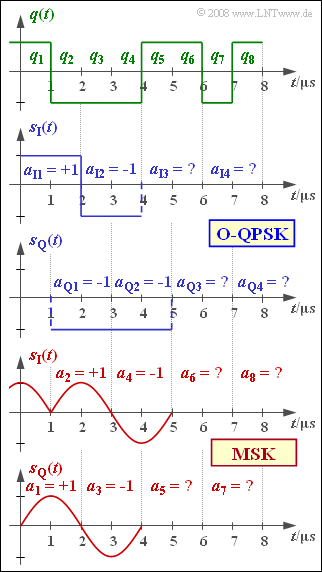Difference between revisions of "Aufgaben:Exercise 4.14Z: Offset QPSK vs. MSK"
m |
m |
||
| Line 44: | Line 44: | ||
<quiz display=simple> | <quiz display=simple> | ||
| − | { | + | {What is the bit duration TB of the source signal? |
|type="{}"} | |type="{}"} | ||
TB = { 1 3% } \ \rm µ s | TB = { 1 3% } \ \rm µ s | ||
| − | { | + | {What is the symbol duration T of the offset QPSK? |
|type="{}"} | |type="{}"} | ||
T = { 2 3% } \ \rm µ s | T = { 2 3% } \ \rm µ s | ||
| − | { | + | {Give the above amplitude coefficients of the offset QPSK. |
|type="{}"} | |type="{}"} | ||
aI3= { 1 3% } | aI3= { 1 3% } | ||
| Line 60: | Line 60: | ||
aQ4 = { 1 3% } | aQ4 = { 1 3% } | ||
| − | { | + | {What is the symbol duration T of the MSK? |
|type="{}"} | |type="{}"} | ||
T = { 1 3% } \ \rm µ s | T = { 1 3% } \ \rm µ s | ||
| − | { | + | {Give the above amplitude coefficients of the MSK. |
|type="{}"} | |type="{}"} | ||
a5 = { -1.03--0.97 } | a5 = { -1.03--0.97 } | ||
Revision as of 17:44, 21 March 2022
One possible implementation fordie MSK is offered by "Offset–QPSK" \rm (O–QPSK), as can be seen from the block diagrams in the theory section.
In "normal offset QPSK operation", two bits of the source symbol sequence 〈q_k〉 are assigned to one bit 𝑎Iν a_{{\rm I}ν} in the in-phase branch and one bit a_{{\rm Q}ν} in the quadrature branch, respectively.
The graph shows this serial-to-parallel conversion in the top three plots for the first four bits of the source signal q(t). It should be noted:
- The Offset–QPSK plot is for for a rectangular-shaped fundamental pulse. The coefficients a_{{\rm I}ν} and a_{{\rm Q}ν} can take the values ±1 .
- If the time index of the source symbols passes through the values k =1, ... , 8, then the time variable ν only takes on the values 1, ... , 4 an.
- The sketch also takes the time offset for the quadrature branch into account.
For a "MSK–implementation using Offset–QPSK" a recoding is required. Here, with q_k ∈ \{+1, –1\} and a_k ∈ \{+1, –1\}, it holds that:
- a_k = (-1)^{k+1} \cdot a_{k-1} \cdot q_k \hspace{0.05cm}.
For example, by assuming a_0 = +1 one gets:
- a_1 = a_0 \cdot q_1 = +1,\hspace{0.4cm}a_2 = -a_1 \cdot q_2 = +1,\hspace{0.4cm} a_3 = a_2 \cdot q_3 = -1,\hspace{0.4cm}a_4 = -a_3 \cdot q_4 = -1 \hspace{0.05cm}.
Additionally, one must take into account:
- The coefficients a_0 = +1, a_2 = +1, a_4 = -1 and the coefficients a_6 and a_8 which are yet to be calculated, are assigned to the signal s_{\rm I}(t) .
- On the other hand, the coefficients a_1 = +1 and a_3 = -1 as well as all other coefficients with an odd index are applied to the signal s_{\rm Q}(t) .
Hints:
- This exercise belongs to the chapter Nonlinear Digital Modulation.
- Particular reference is made to the section Realizing MSK as Offset–QPSK.
- The associated phase function ϕ(t) is determined in Exercise 4.14 , and is also based on the (normalized) MSK fundamental pulse:
- g_{\rm MSK}(t) = \left\{ \begin{array}{l} \cos (\pi/2 \cdot t/T ) \\ 0 \\ \end{array} \right.\quad \begin{array}{*{5}c}{\rm{f\ddot{u}r}} \\{\rm{f\ddot{u}r}} \\ \end{array}\begin{array}{*{10}c} -T \le t \le +T \hspace{0.05cm}, \\ {\rm sonst}. \\ \end{array}
Questions
Solution
(2) Bei QPSK bzw. Offset–QPSK ist aufgrund der Seriell–Parallel–Wandlung die Symboldauer T doppelt so groß wie die Bitdauer T_{\rm B}:
- T = 2 \cdot T_{\rm B} \hspace{0.15cm}\underline {= 2\,{\rm µ s}} \hspace{0.05cm}.
(3) Entsprechend der aus der Skizze für die ersten Bit erkennbaren Zuordnung gilt:
- a_{\rm I3} = q_5 \hspace{0.15cm}\underline {= +1},
- a_{\rm Q3} = q_6 \hspace{0.15cm}\underline {= +1},
- a_{\rm I4} = q_7 \hspace{0.15cm}\underline { = -1},
- a_{\rm Q4} = q_8 \hspace{0.15cm}\underline {= +1} \hspace{0.05cm}.
(4) Bei der MSK ist die Symboldauer T gleich der Bitdauer T_{\rm B}:
- T = T_{\rm B}\hspace{0.15cm}\underline { = 1\,{\rm µ s}} \hspace{0.05cm}.
(5) Entsprechend der angegebenen Umcodiervorschrift gilt mit a_4 = –1:
- q_5 = +1 \hspace{0.3cm} \Rightarrow \hspace{0.3cm}a_5 = a_4 \cdot q_5 \hspace{0.15cm}\underline {= -1},
- q_6 = +1 \hspace{0.3cm} \Rightarrow \hspace{0.3cm}a_6 = -a_5 \cdot q_6 \hspace{0.15cm}\underline {= +1},
- q_7 = -1 \hspace{0.3cm} \Rightarrow \hspace{0.3cm}a_7 = a_6 \cdot q_7 \hspace{0.15cm}\underline {= -1},
- q_8 = +1 \hspace{0.3cm} \Rightarrow \hspace{0.3cm}a_8 = -a_7 \cdot q_8\hspace{0.15cm}\underline { = +1}\hspace{0.05cm}.
